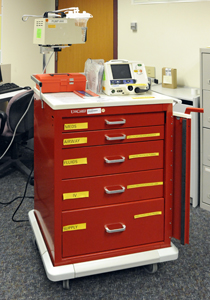Crash cart
Crash Cart[edit]

A crash cart, also known as a code cart, is a set of trays, drawers, or shelves on wheels used in hospitals for transportation and dispensing of emergency medication and equipment at the site of a medical or surgical emergency for life support protocols to potentially save someone's life. The crash cart is a critical component in emergency medicine and is designed to be easily accessible and quickly transportable to the location of a medical emergency.
Components[edit]
A crash cart typically contains the following components:
- Medications: Emergency medications such as epinephrine, atropine, and amiodarone are commonly found in a crash cart. These medications are used to treat cardiac arrest, arrhythmias, and other life-threatening conditions.
- Defibrillator: A defibrillator is an essential piece of equipment on a crash cart. It is used to deliver an electrical shock to the heart in cases of ventricular fibrillation or pulseless ventricular tachycardia.
- Airway Management Tools: Equipment such as endotracheal tubes, laryngoscopes, and bag valve masks are included for securing and maintaining a patient's airway.
- Intravenous (IV) Supplies: IV catheters, fluids, and tubing are available for establishing and maintaining intravenous access.
- Monitoring Equipment: Devices such as blood pressure cuffs, stethoscopes, and pulse oximeters are used to monitor the patient's vital signs.
- Miscellaneous Supplies: Items such as syringes, needles, gloves, and adhesive tape are also included.
Organization and Maintenance[edit]
Crash carts are organized in a standardized manner to ensure that medical personnel can quickly find and use the necessary equipment and medications during an emergency. The layout of a crash cart is often consistent across different departments within a hospital to facilitate ease of use by staff who may work in multiple areas.
Regular maintenance and checks are performed on crash carts to ensure that all equipment is functional and that medications are within their expiration dates. This is crucial to ensure readiness in the event of an emergency.
Usage in Medical Emergencies[edit]
During a medical emergency, such as a cardiac arrest, the crash cart is brought to the patient's location. A team of healthcare professionals, often referred to as a code team, will use the contents of the crash cart to perform advanced cardiac life support (ACLS) or other emergency procedures.
The crash cart allows for rapid response and treatment, which is vital in improving patient outcomes in critical situations. The presence of a well-stocked and organized crash cart can make a significant difference in the success of resuscitation efforts.
Related Pages[edit]
Ad. Transform your life with W8MD's Budget GLP-1 injections from $75


W8MD offers a medical weight loss program to lose weight in Philadelphia. Our physician-supervised medical weight loss provides:
- Weight loss injections in NYC (generic and brand names):
- Zepbound / Mounjaro, Wegovy / Ozempic, Saxenda
- Most insurances accepted or discounted self-pay rates. We will obtain insurance prior authorizations if needed.
- Generic GLP1 weight loss injections from $75 for the starting dose.
- Also offer prescription weight loss medications including Phentermine, Qsymia, Diethylpropion, Contrave etc.
NYC weight loss doctor appointmentsNYC weight loss doctor appointments
Start your NYC weight loss journey today at our NYC medical weight loss and Philadelphia medical weight loss clinics.
- Call 718-946-5500 to lose weight in NYC or for medical weight loss in Philadelphia 215-676-2334.
- Tags:NYC medical weight loss, Philadelphia lose weight Zepbound NYC, Budget GLP1 weight loss injections, Wegovy Philadelphia, Wegovy NYC, Philadelphia medical weight loss, Brookly weight loss and Wegovy NYC
|
WikiMD's Wellness Encyclopedia |
| Let Food Be Thy Medicine Medicine Thy Food - Hippocrates |
Medical Disclaimer: WikiMD is not a substitute for professional medical advice. The information on WikiMD is provided as an information resource only, may be incorrect, outdated or misleading, and is not to be used or relied on for any diagnostic or treatment purposes. Please consult your health care provider before making any healthcare decisions or for guidance about a specific medical condition. WikiMD expressly disclaims responsibility, and shall have no liability, for any damages, loss, injury, or liability whatsoever suffered as a result of your reliance on the information contained in this site. By visiting this site you agree to the foregoing terms and conditions, which may from time to time be changed or supplemented by WikiMD. If you do not agree to the foregoing terms and conditions, you should not enter or use this site. See full disclaimer.
Credits:Most images are courtesy of Wikimedia commons, and templates, categories Wikipedia, licensed under CC BY SA or similar.
Translate this page: - East Asian
中文,
日本,
한국어,
South Asian
हिन्दी,
தமிழ்,
తెలుగు,
Urdu,
ಕನ್ನಡ,
Southeast Asian
Indonesian,
Vietnamese,
Thai,
မြန်မာဘာသာ,
বাংলা
European
español,
Deutsch,
français,
Greek,
português do Brasil,
polski,
română,
русский,
Nederlands,
norsk,
svenska,
suomi,
Italian
Middle Eastern & African
عربى,
Turkish,
Persian,
Hebrew,
Afrikaans,
isiZulu,
Kiswahili,
Other
Bulgarian,
Hungarian,
Czech,
Swedish,
മലയാളം,
मराठी,
ਪੰਜਾਬੀ,
ગુજરાતી,
Portuguese,
Ukrainian